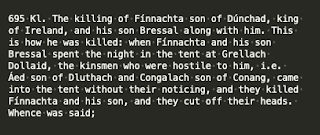Celts, "When their enemies fall, cut off their heads and fasten them about the necks of their horses...." (Diodorus Siculus).
Celtic bronze fibula of a horseman with enemy's severed head (2nd c. BC), Museo Arqueológico Nacional, Spain
A mounted Celtic warrior with what is interpreted as a decapitated head suspended from the neck of his horse. From Entremont (oppidum) France.
In case you are in doubt that this could be a severed head, have a look at this. One of the Celtic warrior statues from Entremont oppidium southeastern France. The warrior is sitting in a lotus position, with the cut off heads of his enemies on his laps. Reconstructed from fragments...
The head of a deceased person placed under a hand (of a seated hero?). The position of the head on the knee of a warrior almost certainly indicates it was one of the trophies accumulated during his life...From official Entremont site..
Closeup of two other heads. One with the hand resting on the head under a streak of long hair...From the official Entremont site...
Te decorated portion of the head-pillar from Entremont, from "Porticos, pillars and severed heads: the display and curation of human remains in the southern French Iron Age"
Decapitated head in one of the scull pillars of the Sanctuary of Roquepertuse, Southern France...From "The head hunters"...
Gold quinarius, Central Gaul, 100-50BC.
Front: female head looking right with inscription DVBNOC[OV] (Dubnocoveros, giant of the world)
Back: warrior standing, holding boar standard in right hand and human head in left hand with inscription[D]VBNOREX (Dubnorex, king of the world)
Some habits die hard...Once a headhunter, always a headhunter...Even if you are now "Roman"...Tombstone of Insus, son of Vodullus of the Treveri, cavalryman of the Ala Augusta. c. 80 AD...Treveri were a Celtic tribe who inhabited the lower valley of the Moselle. And collecting the heads of dead enemies was one of Celtic favourite hobbies...
Finally, in "Porticos, pillars and severed heads: the display and curation of human remains in the southern French Iron Age" we can read that:
"...human crania themselves, sometimes perforated for display, have proved to be a recurrent find on Iron Age archaeological sites right across Europe, from southern France to northern Scotland..."
That head cutting and collecting was a widespread custom among Celts, can be seen from the Irish annals, oral histories first written down during early medieval time by the Irish monks:
Examples of the practice of cutting off the heads of dead enemies, from Fragmentary Annals of Ireland
Example from "The Cattle-Raid of Cooley (Táin Bó Cúalnge)", the chapter entitled "Here Now Cometh The Head-Place Of Ferchu":
"Cuchulain turned on them, and straightway he smote off their twelve heads. And he set up twelve stones in the earth for them, and he put the head of each one of them on its stone and he likewise put Ferchu Longsech's head on its stone..."
I think this is enough to illustrate that this was a widespread practice in Ireland...
Finally we come to "kern". Kern (Anglicised Middle Irish "ceithern", fighting men) was a Gaelic (Irish) warrior, specifically a light infantryman, and light cavalry in Ireland in the late Middle Ages. Like many Gaels historically, Kerns often found themselves on multiple sides of conflicts; for example, the native Irish forces of the Norman-English in Ireland would have had levies of Kerns. As a result, they also found themselves fighting upon distant shores in Europe where they were famous as ferocious light infantrymen. This is a 15th century description of the kerns in action in France:
The Prior and many of his men were killed. The kern had made a strong impression by their outlandish dress and their ferocity, riding back from raids with severed heads dangling from their bareback ponies...


















I've long suspected that the Iron Age production of broad axes, swords and chopping machetes directly resulted in head chopping & collecting fashions in Asia, such as among the head-hunting Dayaks in Borneo. Head-bashing was more common among stone-tool cultures.
ReplyDelete